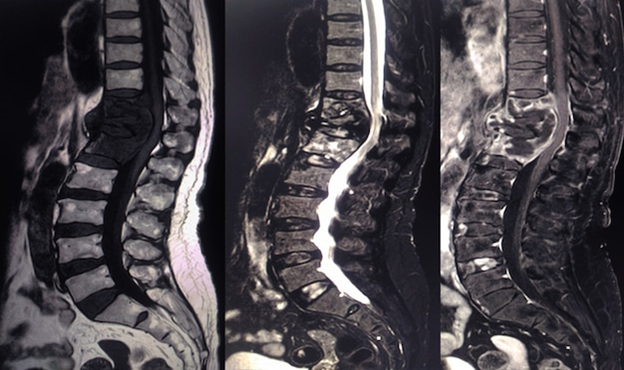Spinal canal stenosis refers to a condition where the spaces in the spine narrow, putting pressure on the nerves running through the spine. Understanding what spinal canal stenosis means and its potential risks are crucial in managing your spinal health. Recognizing its early symptoms can help prevent severe complications.
1. Demystifying Spinal Canal Stenosis
Spinal canal stenosis is a condition that affects the spine by narrowing spaces in it, which can lead to pressure on the spinal cord and nerves. This condition plays a significant role in spinal health, as it impacts how well the spine can perform its essential functions.
The spine is made up of vertebrae, discs, and nerves. It’s like a super protective tunnel for your nerves. When parts of the spine narrow, it can irritate or compress these nerves, causing painful symptoms. There are different types of stenosis, often determined by their location. Lumbar stenosis is when this narrowing affects the lower spine, while cervical stenosis involves the neck area of the spine.
Knowing the differences in these types helps in understanding why symptoms vary. For instance, lumbar stenosis might make it hard to walk or stand for long, affecting the lower body. On the other hand, cervical stenosis can cause neck pain and influence how the arms and hands work. Understanding these differences helps in recognizing the condition early and seeking the right help.
2. Underlying Causes Behind Spinal Canal Stenosis
There are several factors that can cause spinal canal stenosis. A common cause is simply wear and tear from aging. As we age, the spine can develop bone spurs or thickened ligaments, narrowing the space around the spinal cord and nerves.

Less commonly, conditions like birth defects or even tumors within the spine can lead to this narrowing. All these changes mean the nerves are compressed, which then leads to the symptoms many experience. So, understanding these causes can guide preventative measures and timely interventions.
3. Spotting the Symptoms: What to Look For
Recognizing symptoms of spinal canal stenosis is key to early management. In lumbar stenosis, common symptoms include pain or numbness in the legs. Walking or standing might increase the discomfort, while sitting or bending forward can relieve it.
In cervical stenosis, symptoms like neck pain or tingling in the arms are noticeable. It’s also crucial to be aware of severe symptoms, such as sudden paralysis or issues with bladder control. These signs require urgent medical attention. Knowing these symptoms can help individuals seek help before the situation worsens, making the difference in the quality of life one can enjoy.
4. Key Risk Factors: Who’s at Greater Risk?
There are certain factors that increase the risk of developing spinal canal stenosis. Age plays a significant role; people over 50 are more likely to experience these changes due to wear and tear on the spine. Gender also matters, with females having a higher risk than males.
Additional risk factors include previous spinal injuries or surgeries, family history, and conditions like arthritis which affect spine health. Understanding these risk factors can guide in taking proactive measures for spinal health.
5. Diagnosis: Tools and Tactics
Diagnosing spinal canal stenosis involves several tools and tactics. MRI and CT scans are commonly used. These imaging techniques provide a clear picture of the spine and any narrowing present.
Recent advancements, especially in countries like India, have made diagnostics more precise and less invasive. Early diagnosis is crucial. Spotting the condition sooner can prevent severe outcomes and guide effective spinal canal stenosis treatment options before things progress too far.
6. Risks of Delaying Treatment
Ignoring spinal canal stenosis can have serious consequences. Untreated, it can lead to reduced mobility and independence, potentially even leading to permanent nerve damage.
There’s also an impact on mental health. Chronic pain and mobility issues can take a toll on your quality of life, leading to feelings of frustration or depression. Understanding these risks highlights the importance of treating the condition promptly and effectively.
7. Proactive Steps for Prevention and Management
Fortunately, there are steps you can take to prevent or manage spinal canal stenosis. Here are some recommendations:
- Regular exercise: Engaging in activities that strengthen and support the spine, such as walking or swimming, can help.
- Healthy weight maintenance: Keeping your body weight in check reduces stress on the spine.
- Posture improvement: Good posture and ergonomic practices can prevent unnecessary strain on the spine.
- Regular check-ups: These are crucial for catching any spinal issues early, allowing for timely support and intervention.
By adopting these lifestyle habits, you can significantly impact your spinal health and possibly delay or avoid the progression of stenosis.
Conclusion & How The Spine Clinic Can Assist You?
Understanding symptoms of spinal canal stenosis and the importance of early diagnosis cannot be overstressed. Early intervention is key to managing the condition effectively.
At The Spine Clinic, we tailor specialized care and spinal canal stenosis treatment options to each individual’s needs. Whether it’s guiding through lifestyle modifications or providing advanced treatments, The Spine Clinic aims to help you maintain optimal spinal health.
If you notice persistent symptoms or have concerns about your spine, consult with our expert team at The Spine Clinic. Seeking professional advice can provide peace of mind and ensure your spine stays healthy for years to come.
